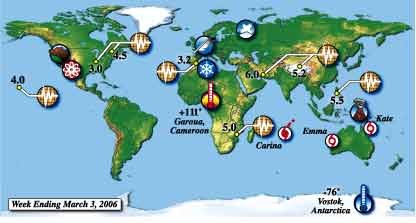A Non-Nuclear Test
The United States and Britain conducted a
”
subcritical
”
nuclear experiment at the U.S. underground test site in Nevada.
It was the 22nd such blast since 1997, according to the Energy
Department.
A Non-Nuclear Test
The United States and Britain conducted a “subcritical” nuclear experiment at the U.S. underground test site in Nevada. It was the 22nd such blast since 1997, according to the Energy Department. The explosion occurred in an underground laboratory of horizontal tunnels about 950 feet beneath the desert surface and was not powerful enough to trigger a nuclear chain reaction. Antinuclear groups have criticized the explosions, saying they undermine the Comprehensive Test Ban Treaty on nuclear weapons. But U.S. officials maintain that the tests provide crucial information to maintain the safety and reliability of the country’s nuclear weapons without having to conduct actual underground nuclear explosions.
Eruption
Thousands of people on Papua New Guinea’s Manam Island were ordered to evacuate as the island’s volcano erupted violently. Manam last erupted in October 2004, prompting an evacuation of more than 9,000 people after falling ash contaminated water supplies and destroyed houses and crops. Islanders were placed in camps on the mainland, but many had returned before the latest eruption.
African Snowstorm
A bitter winter snowstorm blew southward from Western Europe, blanketing a wide area of North Africa with frozen precipitation. Heavy snow cut off villages and clogged key roads leading away from the Algerian capital, Algiers, for several days. Many rural communities were only accessible by mules and donkeys, according to press reports.
Enduring Bird Flu
Concerns that Europe could be in for a long battle with the H5N1 strain of avian influenza grew as the virus was detected in more EU birds and caused the death of a domestic cat in Germany. That country immediately ordered that all pet cats be kept indoors, and dog owners were instructed to keep their animals on a leash. Some frantic pet owners considered giving up their animals altogether. But the World Health Organization assured them that there has never been a human case of bird flu linked with exposure to cats. Britain’s chief scientific adviser, Sir David King, told BBC that he expects the avian influenza outbreak will persist in Europe for at least five years.
Wild Bird Tragedy
A sudden freeze last autumn in the forests of Russia’s Arkhangelsk region caused the deaths of vast numbers of birds, according to wildlife experts. Usually, birds escape wintry conditions there by burrowing into snow or other dens. But a rapid deep freeze that followed heavy rain during the fall left the birds nowhere to shelter, said researcher Vladimir Korepanov. The thick ice also kept the birds from their usual food sources. Korepanov says only 10 percent of the region’s birds survived, and it could take two to three years for their numbers to recover.
Tropical Cyclones
Australia’s northwest corner received heavy rainfall and storm-force winds when Cyclone Emma moved ashore. Local flash flooding blocked some roads, but there were no reports of significant damage from the storm.
Weak Cyclone Kate formed briefly over the open waters of the northern Coral Sea.
Cyclone Carina churned the central Indian Ocean, posing a threat only to shipping lanes.
Earthquakes
More than 1,000 homes in a remote region of southern Iran were seriously damaged when a magnitude 6.0 temblor hit the region. The shaking was felt as far away as the United Arab Emirates.
Earth movements were also felt in the western Mozambique aftershock zone, southeastern Spain, northern Tibet, the central Philippines, the island of Hawaii, southern Illinois and across a wide area of upstate New York, eastern Ontario and western Quebec.
Not Junk to Bears
An abundance of junk food around new housing developments in the United States is responsible for a population boom of bears, according to wildlife experts. Leftover food, full of protein and fat-rich ingredients, is actually increasing the bears’ fertility as well as attracting them to newly populated areas. Kevin Brennan, a wildlife biologist for the California Department of Fish and Game, says the number of bears in the state had risen eightfold in the past 20 years, making them more numerous near cities than in many places in the wild. He adds that a high-fat diet of human scraps creates fatter female bears, who then have litters of two or three cubs, compared to only one or two cubs when they feed on their usual diet of acorns and berries.











